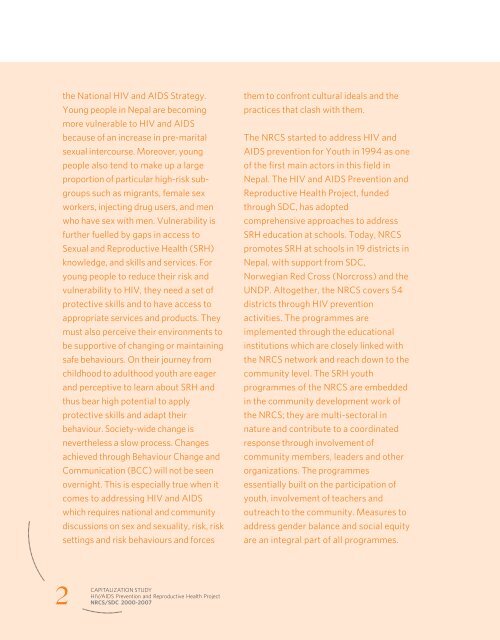HIV/AIDS Prevention & Reproductive Health Project
HIV/AIDS Prevention & Reproductive Health Project
HIV/AIDS Prevention & Reproductive Health Project
You also want an ePaper? Increase the reach of your titles
YUMPU automatically turns print PDFs into web optimized ePapers that Google loves.
the National <strong>HIV</strong> and <strong>AIDS</strong> Strategy.<br />
Young people in Nepal are becoming<br />
more vulnerable to <strong>HIV</strong> and <strong>AIDS</strong><br />
because of an increase in pre-marital<br />
sexual intercourse. Moreover, young<br />
people also tend to make up a large<br />
proportion of particular high-risk subgroups<br />
such as migrants, female sex<br />
workers, injecting drug users, and men<br />
who have sex with men. Vulnerability is<br />
further fuelled by gaps in access to<br />
Sexual and <strong>Reproductive</strong> <strong>Health</strong> (SRH)<br />
knowledge, and skills and services. For<br />
young people to reduce their risk and<br />
vulnerability to <strong>HIV</strong>, they need a set of<br />
protective skills and to have access to<br />
appropriate services and products. They<br />
must also perceive their environments to<br />
be supportive of changing or maintaining<br />
safe behaviours. On their journey from<br />
childhood to adulthood youth are eager<br />
and perceptive to learn about SRH and<br />
thus bear high potential to apply<br />
protective skills and adapt their<br />
behaviour. Society-wide change is<br />
nevertheless a slow process. Changes<br />
achieved through Behaviour Change and<br />
Communication (BCC) will not be seen<br />
overnight. This is especially true when it<br />
comes to addressing <strong>HIV</strong> and <strong>AIDS</strong><br />
which requires national and community<br />
discussions on sex and sexuality, risk, risk<br />
settings and risk behaviours and forces<br />
them to confront cultural ideals and the<br />
practices that clash with them.<br />
The NRCS started to address <strong>HIV</strong> and<br />
<strong>AIDS</strong> prevention for Youth in 1994 as one<br />
of the first main actors in this field in<br />
Nepal. The <strong>HIV</strong> and <strong>AIDS</strong> <strong>Prevention</strong> and<br />
<strong>Reproductive</strong> <strong>Health</strong> <strong>Project</strong>, funded<br />
through SDC, has adopted<br />
comprehensive approaches to address<br />
SRH education at schools. Today, NRCS<br />
promotes SRH at schools in 19 districts in<br />
Nepal, with support from SDC,<br />
Norwegian Red Cross (Norcross) and the<br />
UNDP. Altogether, the NRCS covers 54<br />
districts through <strong>HIV</strong> prevention<br />
activities. The programmes are<br />
implemented through the educational<br />
institutions which are closely linked with<br />
the NRCS network and reach down to the<br />
community level. The SRH youth<br />
programmes of the NRCS are embedded<br />
in the community development work of<br />
the NRCS; they are multi-sectoral in<br />
nature and contribute to a coordinated<br />
response through involvement of<br />
community members, leaders and other<br />
organizations. The programmes<br />
essentially built on the participation of<br />
youth, involvement of teachers and<br />
outreach to the community. Measures to<br />
address gender balance and social equity<br />
are an integral part of all programmes.<br />
2<br />
CAPITALIZATION STUDY<br />
<strong>HIV</strong>/<strong>AIDS</strong> <strong>Prevention</strong> and <strong>Reproductive</strong> <strong>Health</strong> <strong>Project</strong><br />
NRCS/SDC 2000-2007

















